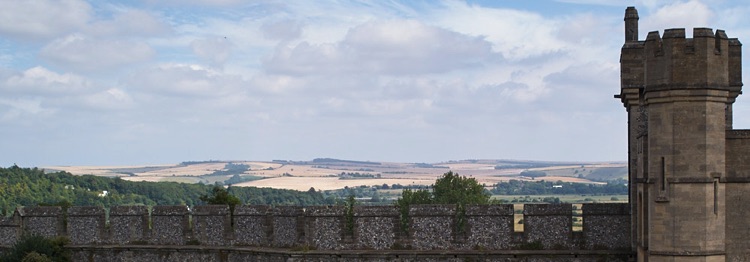Highlights
Medieval battlements and Norman keep
Inside are old masters, armor and period furnishings
Beautiful gardens
Fitzalan chapel
Frequent events staged in the summer
Visitor Information
Seasonal public access with paid admission
Cafeteria, bathrooms and gift shop
Car park in town near castle entrance
½ mile walk from railway station
History
Work was started on Arundel castle in 1068 with the raising of the motte and the digging of the dry moat by Earl Roger de Montgomery, followed by the gatehouse in 1070. The stone keep on the motte was built later by William de Albini
Earl Roger, as he is referred to in the Domesday book, was a trusted counselor of William I. He did not fight at the Battle of Hastings, but stayed in Normandy to protect William’s holdings there. William granted Earl Roger substantial land in England, including the district or rape of Arundel, as it was known. Earl Roger, traveling with William, landed in Winchelsea in December, 1067 to take possession of his new holdings.
Earl Roger and his sons Hugh, Roger and Robert de Bellême joined the Rebellion of 1088 against William II. William suppressed the rebellion and confiscated much of the rebels land. On Earl Rogers death in 1094 Arundel reverted to the crown. In 1097 William II stopped at Arundel on way to hold court in Windsor. In 1100, William II died while hunting in the new forrest and was succeeded by Henry I.
In 1102 Count Robert de Bellême rebelled against King Henry I and was subsequently banished. Count Robert fled to Arundel, where he was besieged by the king. Henry realized that the siege might be of some duration and built emplacements around the castle. While leaving some of his army to maintain the siege, Henry moved on to besiege Bridgnorth, another of Count Robert’s holdings. When Henry returned to Arundel, Robert de Bellême had fled to Normandy.
Robert had a reputation for extreme cruelty. One chronicler reported he blinded his own son at the age of six and took pleasure from impaling prisoners on sharpened stakes. He was later captured by Henry I at the Battle of Tinchedrai and imprisoned for the remainder of his life.
King Stephen granted William de Albini the Honour of Arundel in 1138. Although a staunch supporter of Stephen, William sheltered the Empress Matilda at Arundel on her return to England in 1139. Matilda was staking her claim to the throne which had been promised to her by her father, Henry I. The conflict between King Stephen and Empress Matilda resulted in an extended period of lawlessness in England known as the Anarchy.
Since then the castle passed to the Richard Fitzalan, the 10th earl of Arundel. Richard, the 10th earl fought at Sluys, Tournai and was one of the principal English commanders at Crecy in the hundred years war. After his death in 1376, the castle passed to his son, Richard, the 11th Earl of Arundel.
Richard, the 11th earl, together with the earl of Warwick and the Duke of Gloucester came into conflict with King Richard II. In July 1397, King Richard arrested all three. In September, Richard, earl of Arundel was put on trial and executed. The king seized all the Arundel lands. By 1399, King Richard had alienated enough of his barons that he was forced to abdicate and Henry Bolingbroke took the throne and became King Henry IV.
Richard Fitzalan was succeeded by his son Thomas as the 12th earl of Arundel. Thomas Fitzalan became a trusted advisor of King Henry V. Henry appointed Sir Thomas as Lord Treasurer, the Constable of Dover castle and Warden of the Cinque Ports. Sir Thomas accompanied Henry on his expedition to France, participating in the taking of Harfleur. Sir Thomas became ill, likely with dysentery, shortly after the siege. He was given leave by Henry to return to England where he died. Henry went on to defeat the French at the Battle of Agincourt.
Later the castle came to to the Howards, the Dukes of Norfolk. The castle is home to the current Duke of Norfolk.
The final siege and sack was by Cromwell's Parliamentarian forces in 1643 - 1644. Since then, however, quieter times have prevailed. The castle has now been extensively restored and shows little of the damage inflicted in earlier years.

Arundel Castle
Gallery
Map
Website



